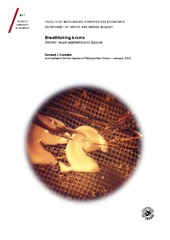| dc.contributor.advisor | Folkow, Lars | |
| dc.contributor.author | Geiseler, Samuel | |
| dc.date.accessioned | 2016-07-11T12:39:31Z | |
| dc.date.available | 2016-07-11T12:39:31Z | |
| dc.date.issued | 2016-04-07 | |
| dc.description.abstract | To maintain and restore the membrane potential that is crucial for normal function of neurons, the brain requires a constant and high energy supply. This supply is mainly covered by oxidative metabolism. When oxygen supply is impaired on a cellular level (hypoxia), such as in the case of stroke, neural energy levels become inadequate to maintain ion balance, leading to excessive ion flux and ultimately to neural death.
Despite the brain’s high vulnerability to hypoxia, a number of animals are exposed to and survive hypoxia on a regular basis. Consequently, these animals must possess intrinsic adaptations to hypoxia. An overview of some of these neural adaptations is presented here, with focus on two diving animal species, the hooded seal (Cystophora cristata) and the eider duck (Somateria molissima).
To cover their energy requirements, mammalian neurons generally seem to aerobically metabolize lactate provided by astrocytes. Energy metabolism in the seal brain, however, appears to be organized differently with regard to the roles of astrocytes and neurons, possibly reducing oxidative stress in neurons and enhancing neuronal anaerobic capacity during hypoxia. In paper I we investigated the role of glucose and lactate as fuel sources in hooded seal neurons. We confirmed that spontaneous neuronal activity is maintained in hypoxia, both in the presence of glucose, but also in lactate and aglycemia. While the first implies an increased anaerobic capacity, the latter is possibly due to the enhanced neural glycogen reserves that we found, which are also found in other hypoxia-tolerant species.
To cope with the reduced energy available during hypoxia, many hypoxia tolerant species reduce brain activity to decrease energy demand. In accordance with this strategy, some neurons in the hooded seal and eider duck brain display a shutdown response to hypoxia. In paper II we showed that KATP-channels are present in the eider duck brain and may contribute to reduce neuronal activity during hypoxia.
In paper III we investigated the effect of hypoxia on neuronal communication in the hooded seal. We showed that hippocampal slices in vitro are able to maintain synaptic transmission for at least 3 h in severe hypoxia. We found attenuated paired pulse facilitation in the seal hippocampus and suggest that this may reflect an altered presynaptic calcium regulation in the seal neurons to mitigate the detrimental effects of excessive calcium influx.
The presented results contribute to our understanding of intrinsic neural adaptations in hypoxia tolerant animals. The underlying mechanisms seem to contribute to a reduction in neural energy demand by attenuating activity, maintain energy balance by adapting metabolism, and employ various molecular mechanisms to protect the brain from hypoxic damage. | en_US |
| dc.description.doctoraltype | ph.d. | en_US |
| dc.description.popularabstract | Våres hjerne er våres forholdsvis energikravenste organ og den høye energibruk blir i hovedsak dekket av aerobisk metabolisme. Slike metabolisme behøver tildekkende oxygen tilførsel. Når oxygen tilførsel er ikke tildekkende oppstå det en tilstand av oxygenmangel på cellulært nivå som kalles hypoxi. Når hjernen er utsatt til hypoxi (for eksempel ved hjerneslag), settes en såkalt excytotoxisk kaskade i gang: Som følge utilstrekkelige oxygen mengder er cellene ikke lenger i stand å produsere nok energi til å opprettholde energibalansen. I følge klarer nervecellene ikke å opprettholde ion-balansen, som fører til ukontrollert in- og utstrøm av uliker ioner og nevrotransmitter fra cellene. Ukontrollert aktivering av diverse prosesser fører til slutt til celledød.
Til tross at oxygen er essentielt i prosessen til å dekke hjernens høye energikrav finnes det dyr som er regelmessig utsatt til hypoxi. Siden hjernen til slike dyr overleve episoder av hypoxi, må dem og deres nervecellene har noen innbygde prosesser og tilpasninger som bidra til deres hypoxitoleransen. Avhandlingen bidra til å forstå slike tilpasninger i 2 dykkende dyr: ærfugl og klappmyss.
Vi kjørte elektrophysiologiske forsøk in vitro, dvs vi målte elektrisk nerveaktivitet i hjerneskiver i ulike situasjoner. En reaksjon som er kjent fra hypoxitolerante dyr er en reduksjon i hjerneaktivitet for å spare energi. Vi fant at en klasse ion-kanaler (KATP-kanaler) finnes hos ærfugl og muligens bidra til en slik reduksjon i hjerneaktivitet i hypoxi.
Hos klappmyss undersøkte vi hvordan nerveaktivitet forholde seg til hypoxi med ulike energikilder. Resultatene er i samsvar med tidligere forsking som indikerer at sel har en spesielt metabolisme som bidra til hypoxi toleransen av sel-hjernen. I tillegg etablerte vi en viktig elektrofysiologisk metode til bruk i store pattedyr (som klappmyss og reinsdyr, i våres tilfelle). Ved bruk av metoden viste vi at selhjerne ikke bare overleve lange episoder av hypoxi, men opprettholde nervecellekommunikasjon (synaptic transmission) for minst 3 timer uten oxygen. Dessuten viser resultatene at klappmysshjernen har en modifisert form av cellekommunikasjon som muligens indikerer økt evne til å regulerer ionebalansen i nervecellene. | en_US |
| dc.description | Paper III of this thesis is as manuscript version not available in Munin. The published version is available in <a href=http://dx.doi.org/10.1016/j.neuroscience.2016.07.034>Neuroscience 334:39-46</a><br>Geiseler SJ, Larson J, Folkow LP (2016). Synaptic transmission despite hypoxia in hippocampal slices of the deep‐diving hooded seal. | en_US |
| dc.identifier.isbn | 978-82-8266-114-0 | |
| dc.identifier.uri | https://hdl.handle.net/10037/9426 | |
| dc.identifier.urn | URN:NBN:no-uit_munin_8977 | |
| dc.language.iso | eng | en_US |
| dc.publisher | UiT The Arctic University of Norway | en_US |
| dc.publisher | UiT Norges arktiske universitet | en_US |
| dc.rights.accessRights | openAccess | |
| dc.rights.holder | Copyright 2016 The Author(s) | |
| dc.rights.uri | https://creativecommons.org/licenses/by-nc-sa/3.0 | en_US |
| dc.rights | Attribution-NonCommercial-ShareAlike 3.0 Unported (CC BY-NC-SA 3.0) | en_US |
| dc.subject | VDP::Mathematics and natural science: 400::Zoology and botany: 480::Zoophysiology and comparative physiology: 483 | en_US |
| dc.subject | VDP::Matematikk og Naturvitenskap: 400::Zoologiske og botaniske fag: 480::Zoofysiologi og komparativ fysiologi: 483 | en_US |
| dc.title | Breathtaking brains
Intrinsic neural adaptations to hypoxia | en_US |
| dc.type | Doctoral thesis | en_US |
| dc.type | Doktorgradsavhandling | en_US |


 English
English norsk
norsk


